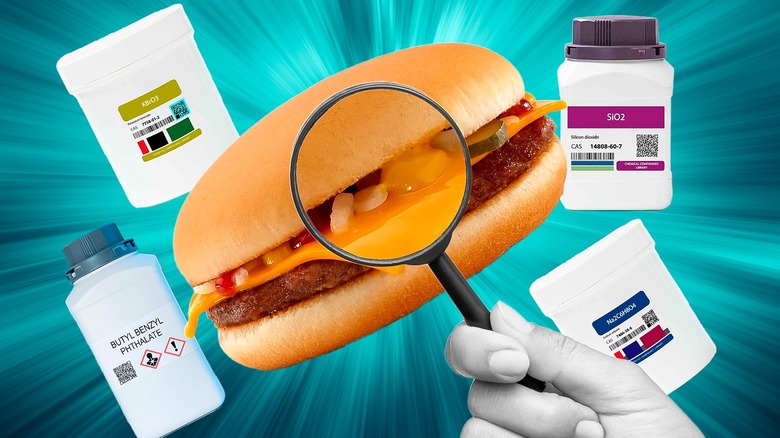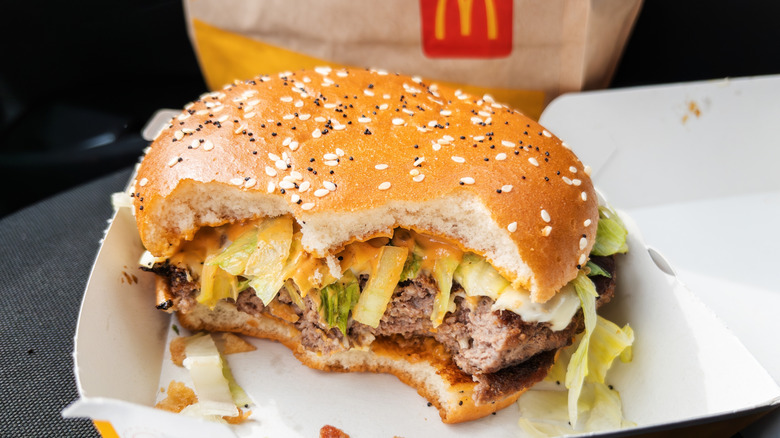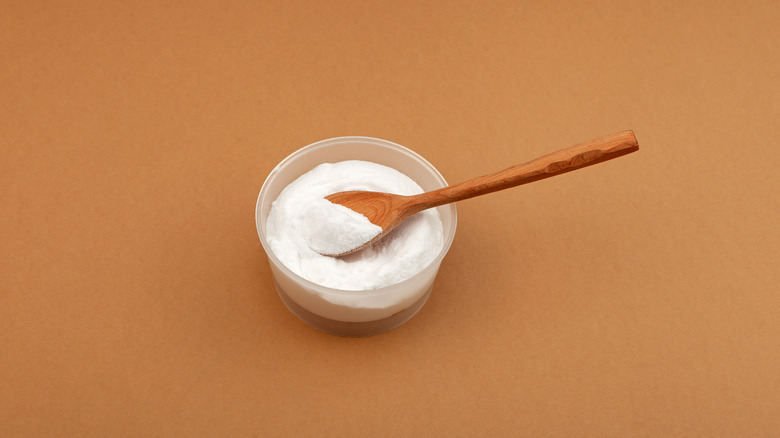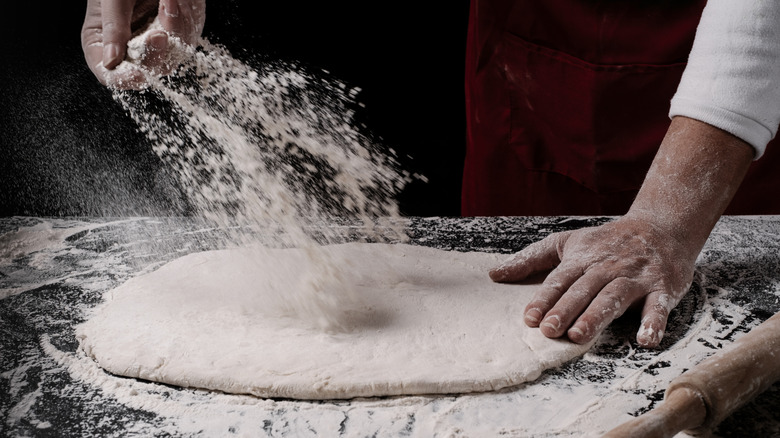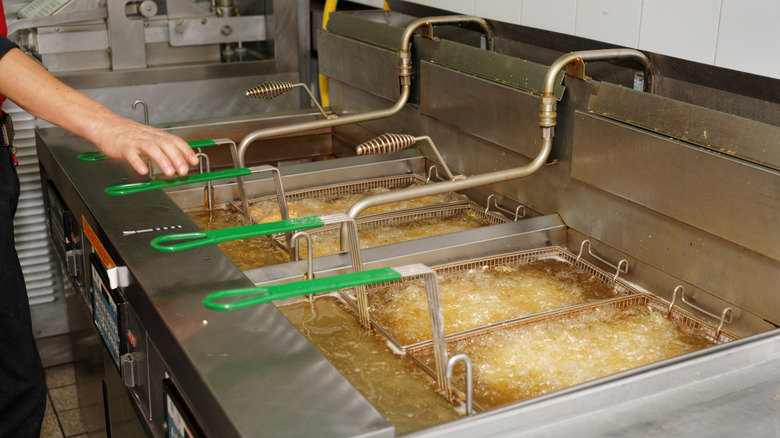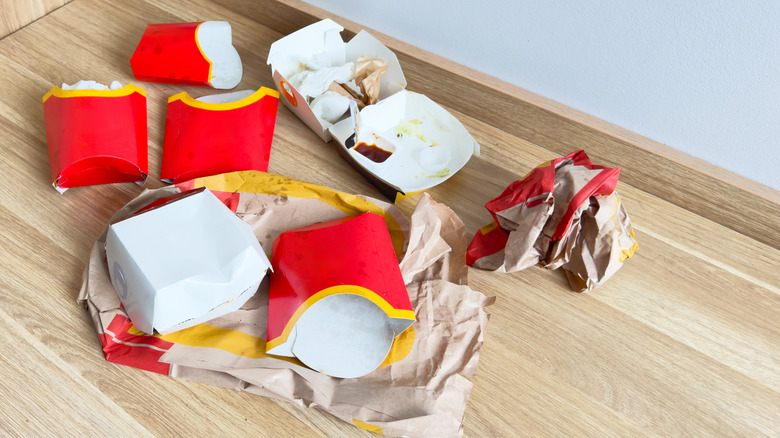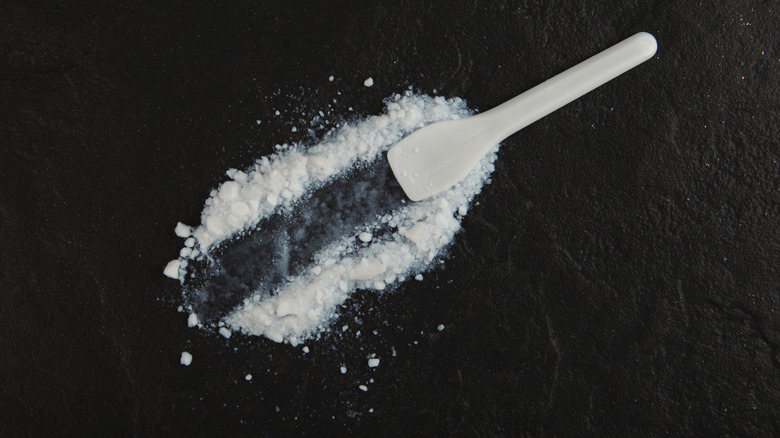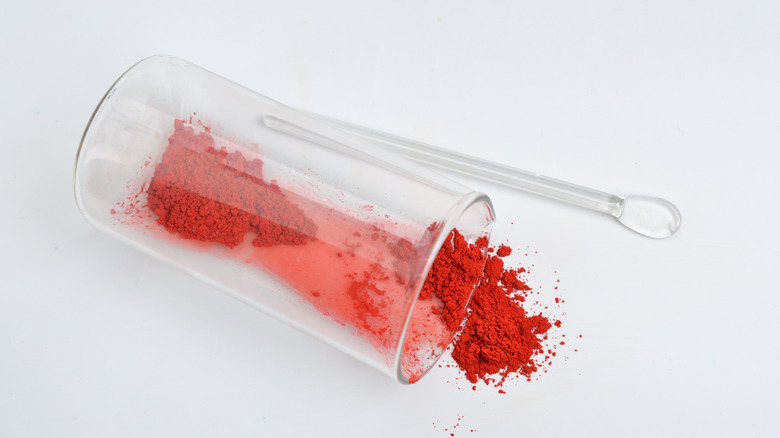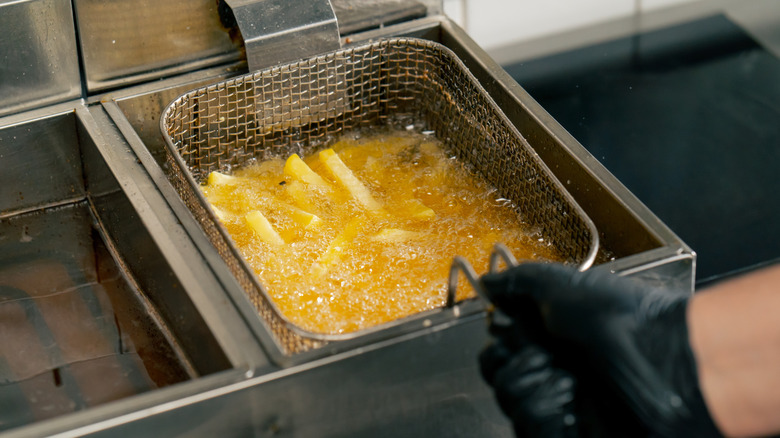10 Fast Food Ingredients That Should Send You Running
It's a true wonder why fast food is so expensive these days. While it's no secret that inflation is always to blame when it comes to rising prices, including those of our favorite eateries, it's also common knowledge that fast food joints don't reliably use high-quality or healthy ingredients. The industry has found ways to make its menu items last longer, taste better, and look more appealing, all while getting orders out faster and still cutting down on costs. But sadly, this is usually accomplished through the inclusion of harmful, and sometimes downright yucky, additives.
From Arby's beef to Dairy Queen's ice cream, a myriad of chemicals with hard-to-pronounce names are lurking in the ingredients of people's go-to fast food orders. Some of these ingredients are derived from head-tilting sources while others are simultaneously being used outside of the food world, begging the question of why humans are being fed the same elements found in glass or silly putty. And even worse, what all of these additives have in common is a lengthy list of negative side effects you're at risk for if you're exposed to too much of the stuff.
Mechanically separated meat is treated with ammonia
From a hot coffee lawsuit to getting rid of all day breakfast, some of the worst mistakes in McDonald's history simply can't be undone or forgotten. But of the things McDonald's has done wrong in the past, making the choice to switch away from mechanically separated meat isn't one of them. Also referred to as "pink slime" due to its slimy, paste-like texture, mechanically separated meat refers to the tiny scraps of meat tissue that are removed from animals' bones via a high-pressure process. This meat is then sprayed with ammonia to kill off bacteria.
Despite the ongoing debate of whether or not this byproduct can be regarded as real meat, it doesn't take away from the fact that many customers are still wary of this inexpensive filler ingredient. That's especially the case considering some of the dangers and downsides that accompany mechanically separated meat, including a bitter taste, bad smell, less protein, and more microorganism growth. So it's no wonder big time chains like McDonald's eventually made the choice to eliminate the use of pink slime in its menu ingredients altogether. In 2011, the golden-arched establishment released a statement announcing this decision. The company reiterated the fact in 2018 that no mechanically separated meat is used in its chicken products and again in 2021 concerning its beef patties. Eateries like Taco Bell and Burger King have followed suit as well.
Phosphate additives can contribute to multiple diseases
You've likely heard the word phosphate before. It's an essential nutrient that our bodies require for a number of reasons, including but not limited to healthy bones and teeth and the development of cell membranes, cell energy, and DNA. This compound is obtained through the many foods that are available to us, from bread and potatoes to milk and egg yolks. It's important to note, though, that our bodies require naturally occurring phosphate — not the phosphate additives that are being put into fast food.
According to a study conducted in 2008, there are very few fast food chains that don't use phosphate additives. It's implemented to slow the discoloration of meat, increase the amount of water meat can hold, prevent bacteria growth, and make foods creamier and less clumped together, among other reasons. You'll find it as an ingredient in a range of items, all the way from soft drinks and confectionery items to cheese and processed meat. Inorganic phosphates are very easily absorbed by the human body, meaning the smallest amounts can still have an impact and contribute to your overall phosphorus levels. Having too much of this in your system can lead to health issues, especially for those who are required to adhere to a low-phosphorus diet. More specifically, too many phosphate additives can contribute to cardiovascular disease, metabolic disorders like diabetes and obesity, bone disease, and irritated eyes.
Sodium benzoate may increase inflammation
To eat burgers with pickles on them or to ask for them to be taken off; that is the age-old debate. Die-hard pickle fans who love to have the sour, green ingredient as part of their order might be swayed to the other side once they learn of the chemicals they contain. The same goes for those who normally enjoy certain condiments, salad dressings, sodas, and fruit juices, as each of these commonly have sodium benzoate in them.
Sodium benzoate is often used to maintain the freshness of processed foods, such as Wendy's barbecue nugget sauce or the crinkle cut pickle slices in McDonald's McCrispy. The additive prevents the food from changing in color, flavor, and texture. Though the U.S. Food and Drug Administration isn't concerned about sodium benzoate when it's consumed in minimal amounts, there are still complications that can come along with the man-made chemical. One of the biggest caveats to sodium benzoate is that when it combines with vitamin C and is exposed to too much heat or light, it can create benzene, which is a dangerous carcinogen. Even all on its own, sodium benzoate can lead to inflammation, an increase in signs of attention deficit hyperactivity disorder (ADHD), swelling, and itching.
Potassium bromate is a possible carcinogen
Perhaps the most alarming on the list of fast food additives is potassium bromate, though the use of the word potassium makes it seem like it should actually be the least harmful. After all, don't people load up on bananas just to get more of the mineral? While that's true, the key word in this additive's name is "bromate." The attachment of potassium and bromate to one another creates a whole new meaning, now referring to a chemical additive commonly put into fast food breads and dough. Potassium bromate is an oxidizing agent, which essentially improves dough by helping it to rise and enhancing its texture.
That all sounds well and good for the sake of pizzas and bread being sold by American chains like Pizza Hut, Domino's, and KFC, all of which utilize the chemical compound. But outside of the United States, several parts of the world have banned the stuff. Potassium bromate is not allowed in Europe, China, and India. And that's only a few of the places that have recognized the dangers of potassium bromate. A 2023 study showed that bakers who worked with this toxic ingredient experienced issues like diarrhea, sore throats, pain in their eyes, and kidney disorders. It also poses a possible carcinogenic risk to those who consume it. The additional possible side effects go on and on, from hearing loss to neuro-behavioral changes. But even with these downsides, the United States has yet to prohibit the additive, and the FDA currently deems it safe so long as the ratio used is around one teaspoon of potassium bromate to 800 cups of flour (via the FDA's website).
Tertiary butylhydroquinone can impact the effectiveness of chemotherapy in high doses
When nitpicking the negative health aspects of fast food, the first thing people will usually mention is the copious amounts of oil everything is fried in. Oil is not only high in calories and saturated in unhealthy fats, but it can also be filled with harmful substances -– some that form on their own and some that are purposely added. Tertiary butylhydroquinone (TBHQ) is a part of the latter group, and from boxed muffin mixes and name brand cereals to chocolate and ice cream bars, it's hiding in a wider range of food items than you can imagine.
Surprise, surprise; TBHQ is a preservative that's also used by fast food restaurants. It's often put in establishments' frying oil to act as an antioxidant, in turn slowing down the commodity's deterioration rate and lessening its need to be changed as quickly or frequently. The U.S. Food and Drug Administration declares TBHQ to be generally regarded as safe so long as it meets a certain set of criteria, one of which being that "the additive will not exceed 0.02 percent of the oil or fat content of the food" (via the FDA's website). However, if consumed in excessive amounts, TBHQ can cause notable issues. The chemical can increase the risk of cancer while also making chemotherapy less likely to be effective. Even neurological issues can arise from the preservative, including vision issues and paralysis.
Phthalates have been linked to disruptions in hormone production
Fast food is called fast food for a reason. A lot of the time it's thrown onto conveyor belts, chucked into paper and plastic containers, and speedily assembled by employees wearing rubber gloves. These shortcuts are all part of how the industry impressively gets orders out to hungry and busy customers in under just a few minutes. But these food processing steps are also the contributing factors for why phthalates can be found in fast food items.
Phthalates are chemicals that make plastics both stronger and more flexible at the same time. In a fast food joint where there's loads of this chemical present, from the food's packaging to the disposable gloves the crew is required to wear throughout the preparation process, it's hardly surprising that the phthalates would make its way into the food people ingest. Plus, heat exposure, which can't be avoided at a restaurant, makes the transfer between hot food and chemical-ridden gloves especially easy. So the assumption that fast food becomes contaminated with phthalates would be correct, as more than one study has proven it to be true. For example, according to Consumer Reports, there were large amounts of phthalates in Wendy's chicken nuggets, Chipotle burritos, and even Burger King Whoppers. The same goes for Pizza Hut's original cheese Pan Pizza, though it was a lesser amount. Indulging in these orders and, therefore, the phthalates they contain, poses several risks, including but not limited to disrupting hormone production and regulation. That in itself can lead to a myriad of problems such as an increased risk of diabetes, heart problems, and even cancer. Phthalates are also particularly dangerous to pregnant women and can cause birth defects in their children.
Silicon dioxide is also found in glass and cement
Nothing is better than sitting on a beach with the perfect mai tai or a classic hurricane cocktail in hand and warm sand running between your toes and fingers. And that's exactly where sand should stay. Either there or in a children's sandbox, but never in our food. That's unfortunately exactly where it has ended up, though, in the form of a natural compound called silicon dioxide.
Silicon dioxide is used as an anti-caking agent in items like Wendy's Chili con Carne and Taco Bell's sausage patties. It helps to prevent ingredients within food from absorbing moisture and clumping together. And while that certainly makes for a more texturally pleasing chili experience, it's apparently the same compound that's used in making cement and glass. Also known as silica sand, silicon dioxide is resistant to chemical reactions when used in combination with other materials, allowing for more durable glass and cement. Thankfully, the grade of silica required for building these kinds of infrastructure is not the same as the one used for culinary purposes, as only the smallest possible amount of silicon dioxide is permitted in dishes. But it's nonetheless off-putting to know the same compound that lies on your plate lies in the pavement beneath your feet, too.
Artificial dyes are made from questionable ingredients
With cheese as bright yellow as the sun and tortilla strips as red as fire, does it really come as a surprise to anyone that fast food chains use synthetic dyes to give things that unnaturally perfect hue? Names like Red 40, Yellow 5, Green 3, and Blue 2 aren't a shock to find on any ingredient list these days, whether it be for the snacks that adorn grocery store aisles or the ready-made meals you buy at eateries. But as much as these give your lunch a more aesthetic, appetizing appearance, that's about as far as their benefits reach. It goes downhill from there, starting with what some of these food dyes are made from.
Take carmine, for example. It's a deep red, slightly purple dye used to color a number of products, from lipstick and eyeshadow to pills and ointments. And of course, pastries, candy, beverages, and other food items, too. But its other name, cochineal, is an indicator of its unsettling origins: carmine is derived from a specific type of female insect. The possible side effects of ingesting this ingredient are even more stomach-churning: wheezing, rashes, and face swelling, to name a few. Other artificial food dyes aren't much better, as they're usually made from petroleum. In fairness, the U.S. Food and Drug Administration first approves of certain dyes to ensure they're safe for consumption. However, it doesn't completely eliminate the possibility of negative effects, such as increased hyperactivity, attention problems, and risk of cancer. Children are especially susceptible to these issues.
L-cysteine can come from duck feathers and human hair
From being able to use canned duck for a quick gourmet meal to using duck fat on your savory roast potatoes, the protein source has proven to be handy when it comes to cooking. But the poor creatures are getting more use made out of them than most people realize, as even the feathers of these birds are being utilized in the kitchen. Duck feathers are a natural source of l-cysteine, an amino acid that acts as a dough conditioner and can extend food's shelf life while simultaneously improving its taste. The feathers are boiled in a special solution that allows the protein within it to be broken down, in turn isolating the l-cysteine so it can be further purified and used in food.
Duck feathers aren't the only place to get this amino acid, though. It can also be found right on top of our very own heads. That's right — human hair has been a source of l-cysteine even in the past. In particular, it's been said that Chinese women used to sell their hair to chemical processing plants in order to provide for their families. Hair was also collected from the floor of Chinese barbershops. Animal-derived l-cysteine is what's largely used now, but regardless of where the amino acid is coming from, neither option sounds all that appetizing. It might make you rethink your choices at places like Dunkin' Donuts or Burger King, both of which use this chemical in their food.
Dimethylpolysiloxane is the main ingredient in silly putty
In an industry that profits off the general public's love for the satisfying crunch, crisp outer layer, and tender interior provided by heavily fried foods, it only makes sense that fast food chains seek out ways to safely and efficiently use oil. Otherwise, restaurants' fried chicken and french fries wouldn't be churned out like clockwork as they typically are. More specifically, neither would Domino's breadsticks, Taco Bell's cinnamon twists, or Five Guys' french fries, as each of these popular offerings contain a particular chemical that helps keep the oil safe and easier to work with.
That special ingredient would be dimethylpolysiloxane. Dimethylpolysiloxane is an anti-foaming agent that thankfully keeps cooks safe by preventing oil from excessively splattering or bubbling when food is dipped into it. And while that's certainly an important factor to consider when it comes to the crew's protection, it's still hard to ignore some of the other eyebrow-raising uses of dimethylpolysiloxane that are highly unrelated to food. Not only is the chemical used in many skincare products, shampoos, and conditioners, but it's also the main component of silly putty, a nostalgic children's toy that's characterized by its bouncy, stretchy quality. That's all thanks to dimethylpolysiloxane, which also makes up the silicone gel filling that gives breast implants their flexible texture.
